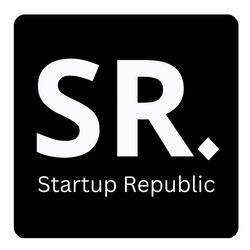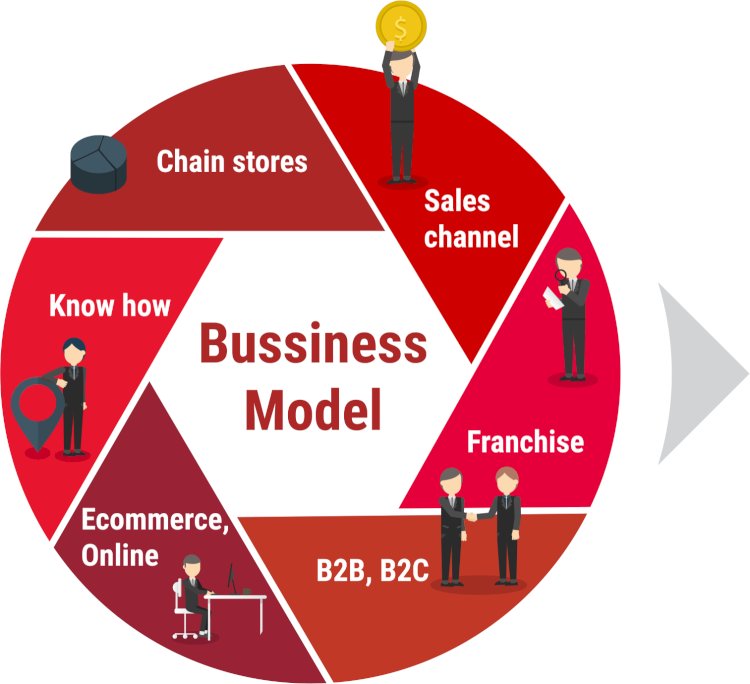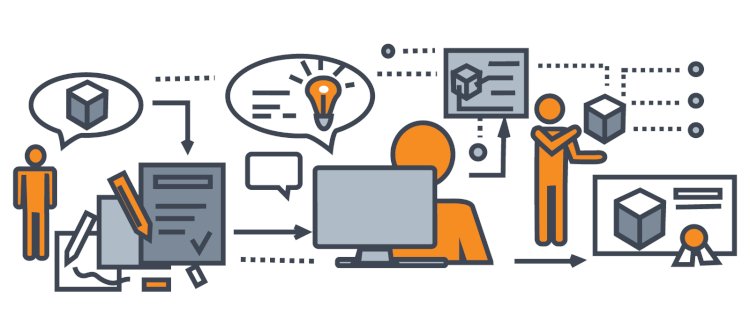What Is a Business Model and How Does It Work?
A business model is a blueprint for how a company will generate profit. In the end, it basically comes down to a company's potential to its essence. A business model addresses fundamental questions about the problem Whether you're establishing a new firm, expanding into a new area, or changing your go-to-market strategy, developing a successful business model is critical. You may utilise a business model to centralise all of your assumptions and conclusions regarding the opportunity, ensuring that you're on the right track.

One of the most crucial components of the process of starting a business is planning. Although it may be time-consuming, you should spend the beginning stages of your business planning what you'll sell, who your consumers will be, and how you'll generate money.
What is the definition of a business model?
A business model is a blueprint for how a corporation intends to make money in a certain market with its product and client base. A business model outlines four things at its core:
- What a corporation will sell as a product or service.
- Its marketing strategy for that goods or service.
- What kind of costs it will have to deal with.
- How it intends to make money.
Because there are so many different sorts of organizations, business models are continuously evolving.
Subscription model, in which companies charge clients monthly, annual, or other prices to access a service, is a popular example of a business model. Of course, each organization's business model can be altered and adapted, but let's use Netflix as an example and split it down based on the four factors:
- What type of product or service a business will offer: Netflix offers an internet streaming service.
- Its marketing strategy for that product or service is as follows: Netflix employs a multichannel marketing strategy, promoting its service via social media, email marketing, advertising, and even word-of-mouth.
- What type of expenses will it face: As a Fortune 500 company, Netflix's expenses are numerous, but perhaps most notably, the price of producing or acquiring content for its platform, as well as the technology and personnel required to run the service.
- When it comes down to it, Netflix intends to make a profit on its membership sales, despite the fact that it is such a massive company (and has a few other means of producing money).
Business model's most important elements
When it comes down to it, business models exist in a number of different forms, but they all have the same basic components. You won't be able to make money until you have those elements. The following are the ten elements to keep in mind:
- Value proposition: A feature that makes your product attractive to customers.
- Target market: A specific group of consumers who would be interested in the product.
- Competitive advantage: A unique feature of your product or service that can’t easily be copied by competitors.
- Cost structure: A list of the fixed and variable expenses your business requires to function, and how these affect pricing.
- Key metrics: The ways your company measures success.
- Resources: The physical, financial, and intellectual assets of your company.
- Problem and solution: Your target customers’ pain points, and how your company intends to meet them.
- Revenue model: A framework that identifies viable income sources to pursue.
- Revenue streams: The multiple ways your company can generate income.
- Profit margin: The amount your revenue exceeds business costs.
The following are the most typical company models:
- The subscription-based model
Internet businesses can benefit from a subscription business model. In essence, as we stated in relation to Netflix, a consumer pays a monthly (or other predetermined timeframes) recurring payment for access to a service or product. You can pay a charge to use an app or a corporation can ship its product directly to you in the mail.
Examples: HelloFresh, Beer Cartel, Stitch Fix, and other streaming services including Hulu, HBO Go, and Disney+ are among the companies that use the subscription model in addition to Netflix.
- Bundling strategy Model
Bundling is a business model that involves enterprises offering two or more things as a single unit for a cheaper price than they would charge if they sold the products separately.
This type of business model enables organizations to create a higher volume of sales and possibly promote more difficult-to-sell products or services. Profit margins, on the other hand, frequently drop as enterprises sell things for less.
AT&T, Adobe Creative Suite, Burger King, and other fast-food restaurants that provide value meals or offers are examples of corporations that use the bundling approach.
- The freemium business model
With the rise of internet and Software-as-a-Service (SaaS) firms, the freemium business model has gained traction.
The basic architecture is as follows: a software corporation hosts and provides a proprietary product, such as an app or tool suite, for their users to freely access. However, the corporation withholds or restricts the use of certain essential features that users are likely to want to use more frequently over time. Users must pay a subscription fee to have access to those important services.
Spotify, for example, follows this approach by providing users with free and open access to their full music library while interspersing advertisements between songs. Many customers eventually decide to pay a regular monthly price for the premium service in order to listen to music uninterrupted.
Spotify, LinkedIn, Skype, and Mail Chimp, for example, are all freemium enterprises.
- Razor blades Model
Simply go to your local drugstore to learn about the razor blades model. Replacement razor blades are more expensive than the razors themselves.
Companies will sell you a less expensive razor if you promise to buy more expensive accessories — in this case, razor blades — in the future. As a result, this variant is known as the "razor blades model."
In addition to the classic razor blades model, you'll see businesses adopt the reverse razor blades model, in which they provide clients with a high-margin product and then encourage the sale of lower-margin products that go along with it.
Apple iPhones and Macs are a famous illustration of this model: you buy the high-margin item, the phone or computer, and then Apple promotes extra products, tools, and services that go with it.
Examples of the general razor blades model include Keruig, Brita, Xbox, and printer and ink companies, in addition to razor companies.
- Product-to-service Model
Assume you are the owner of a scooter manufacturing company. Assume you need two metal components welded together. Instead of acquiring a welding machine, you might have another company join the metal pieces together. This example demonstrates how the product-to-service business model works.
Customers can buy a result rather than the equipment that provides that result from businesses that use this business model.
Zipcar, Uber, Lyft, and LIME are examples of companies that leverage the product to a service model.
- Leasing Business model
A company acquires a product from a seller in a leasing business model. For a charge, that firm then lets another company use the product they purchased. Large-ticket items, such as manufacturing and medical equipment, are ideally suited to leasing agreements.
Companies that use the leasing model include U-Haul, Enterprise, and Rent-a-Center, to name a few examples.
- Crowdsourcing Model
Crowdsourcing entails gathering information, opinions, or work from a large number of individuals via the internet or social media. Without needing to hire in-house personnel, these business models allow organizations to tap into a wide network of talent.
For example, some traffic applications encourage drivers to report incidents in real-time so that other app users can benefit.
Wikipedia, YouTube, IMDB, and Indiegogo are just a few examples of companies that use the crowdsourcing concept.
- One-to-one Model
The one-for-one business model, as the name implies, entails a corporation donating one item to a charitable organization for every item purchased. This strategy appeals to customers' benevolent natures and social conscience in order to persuade them to buy a product or service, while also allowing both the business and the customer to participate in charitable activities.
TOMS founder Blake Mycoskie is credited for pioneering this type of social entrepreneurship.
Companies that adopt this business model include TOMS, SoapBox, Smile Squared, and Warby Parker, to name a few.
- Franchise business model
The franchise model is possibly the most well-known of all the numerous types of company models; after all, we all see and perhaps visit franchise businesses on a regular basis.
In a nutshell, a franchise functions as follows: A franchise is a pre-established company model that the buyer, the franchisee, simply buys and replicates. The franchiser, or original owner, assists the franchisee with financing, marketing, and other business procedures in order to ensure that the firm runs smoothly. In exchange, the franchisee pays a share of the profits to the franchisor.
Starbucks, Domino's Pizza, Subway, McDonald's, and the UPS Store are all instances of franchise businesses.
- Distribution Model
Distributorship companies are in charge of getting manufacturing items to the market.
For example, Hershey's creates and packages its chocolate, but distributors transfer and sell the items from the plant to a retailer. Distributors acquire the product in bulk and offer it to retailers at a higher price to make a profit.
Examples: HD Supply, Avent, Cheney Brothers, and ABC Supply Co. are some companies that use the distribution business model.
- Manufacturer Model
The manufacturer model refers to when a manufacturer changes raw materials into a product, and it is one of the most conventional business models.
Companies like Dell Computers and Hewlett-Packard, who construct computers with parts made by others, are still called manufacturers.
Intel, Magic Bullet, Black + Decker, and LG Electronics are among more companies that use this business strategy.
- Retailer Model
The retailer business model is the last on our list.
The last link in the supply chain is the retailer. These companies buy items from wholesalers and then sell them to customers for a price that covers their costs while also making a profit. Retailers may specialize in a specific area, such as kitchenware, or provide a wide variety of items.
This is a common business model used by big-name retailers such as Nordstrom, Home Depot, Target, and Best Buy.
What factors should be considered before selecting a business model?
Begin with your small-business concept and ask yourself these questions:
- What is the benefit of the product or service to the customer?
- How the company is going to make money?
- Who is an ideal customer?
- What will the expected beginning costs be?
- Which expenses will be fixed and which will be variable?
- Do We require financial assistance from investors?
You'll be able to better grasp how to structure your business model once you've answered these questions.

 Lalita Singh
Lalita Singh 

























